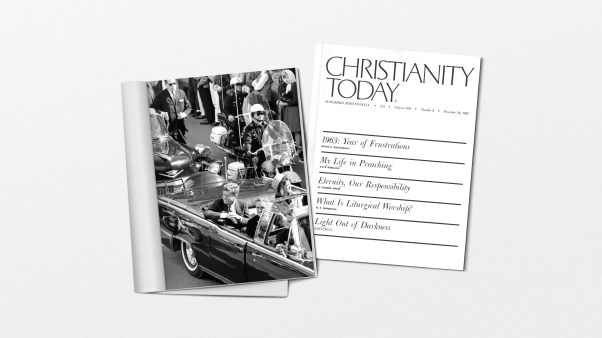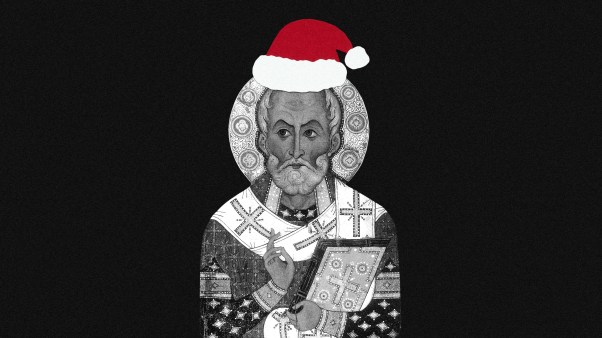While blacks in America are searching for a genuinely black theology, they might do well to rediscover that an authentic black faith already exists. It is known as Pentecostalism.
If this description of Pentecostalism as a black faith is offensive to some whites, especially to those within the movement itself, the reason may be a general lack of knowledge about the origins and sources of Pentecostalism. For the origins of the movement—which includes practicing charismatics in nearly every denomination—are distinctively African and Afro-American.
This fact has some startling implications. First, since scholars consider some elements of Pentecostalism to resemble closely the early Church, primitive Christianity is not foreign to the experience of American Negroes and hence is not totally a white imposition. Second, while it is true that whites have tended to impose certain aspects of a culturized religion on black churches, it is also true that blacks have given to more than a million whites a religious form that is significantly Afro-American. Third, since isolated incidents of glossolalia have appeared and disappeared at regular intervals in church history, it is not unreasonable to suggest that without the important role of blacks, there might be no Pentecostal movement of any magnitude today in the United States or the world. Fourth, the ecumenical and interracial factors inherent in Pentecostalism may offer mainstream Christianity, both Catholic and Protestant, some direction in building a truly integrated church.
White charismatics, as distinct from black participants, have captured considerable attention in the news media. Much notice has been given to the appearance of glossolalia in the large denominations and on university campuses, to the fervent proselytism of the Full Gospel Businessmen’s Fellowship International, to the fast growth of the Assemblies of God and several Churches of God, and now to the explosion of the Jesus movement. All these groups are bastions of white membership. Little wonder, then, that the glossolalic churches have come to be viewed as fringes of the white religious establishment.
Consider, however, that there are 800,000 members of fourteen all-black Pentecostal denominations and probably an equal number in the storefront churches of the ghettos. The white Pentecostal churches are virtually all-white, sharing in a politically conservative or Southern mentality. There is almost no visiting back and forth between the two racial groups, and no mention is ever made of any past withdrawal of black churches from white ones. Is it not strange that no one has inquired about the origin of the black Pentecostal bodies? Evidently popular assumption has it that the gift of tongues fell spontaneously and separately on the non-glossolalist black and white churches. However, this is far from the truth.
Both black and white Pentecostalism in America can be traced back to a little band of black believers who met in a storefront church on Azusa Street in Los Angeles in 1906. Nearly every charismatic denomination in this country can trace its beginnings back to that black church setting. Whatever its biblical base or lack of it, Pentecostalism derives from black people in an immediate, although not exclusive, sense.
Some will say this is overly simplified. For example, the Church of God (Cleveland, Tennessee) has long preferred to emphasize a singular outpouring of charisma in 1896 in Tennessee as its antecedent. But that phenomenon did not last long, and the main introduction of tongues to that body of churches ten years later was linked to Azusa.
Others may suggest that C. F. Parham’s Bethel Bible College, a short-lived, racially integrated school in Topeka, Kansas, should be considered the starting point for the movement. It is true that many of the forty students enrolled there received the manifestation of tongues in 1901, five years prior to Azusa, but the incident was virtually isolated. The flame did not pass to other areas of the country at that time. Sister Lucy Farrow, a black minister, took the message of Pentecostalism from the college in Topeka to Houston, paving the way for Parham to establish a similarly short-lived, racially integrated Bible school there in 1905. By this time, Parham’s evangelistic efforts had been so successful that there were 25,000 Pentecostal believers in Texas alone. From Houston it was a black minister, W. J. Seymour, who took the message to Los Angeles.
Here begins the modern genesis of the movement. When he arrived in Los Angeles, Seymour gathered a body of Negro saints into homes and later into the refurbished lumber store that became the Azusa Mission to pray for a recurrence of apostolic signs and miracles. Then it happened: multitudinous gifts, signs, and manifestations—including tongues-speaking—heralded the advent of the Spirit. For days these black saints shouted and spoke in tongues while others were converted or healed. News of the continuous revival and of the recurrence of glossolalia flashed across the United States.
Soon, in a kind of reverse desegregation, white people began attending and receiving the same experiences through the ministry of the blacks who led the meetings. The disunity of races was temporarily mended, and on the terms of God as proclaimed by a black man, W. J. Seymour.
A chain reaction followed.
The Church of God in Christ, originally a Wesleyan body, heard of the Los Angeles occurrences and sent its overseer, C. H. Mason, to investigate. He returned to Memphis headquarters speaking in tongues. The church then reorganized as a Pentecostal denomination. Today, with more than 400,000 members, it is the second-largest Pentecostal body in America and the largest such black group.
The largest and best known of the white Pentecostal fellowships, the Assemblies of God, has its roots in the Topeka and Azusa sites also. In fact, some of the men who founded the Assemblies in 1914 had previously received ordination credentials from Mason and his all-black Church of God in Christ.
The Pentecostal Holiness Church, a white denomination headquartered in Franklin Springs, Georgia, was also influenced by Azusa. Three Holiness bodies officially accepted the additional Pentecostal doctrine and reorganized as one tongues-speaking church a few years after one of their ministers, G. B. Cashwell, returned from the black-dominated California revival.
Furthermore, it was during a church service conducted by Cashwell that the Church of God (Cleveland, Tennessee) general overseer A. J. Tomlinson received his first Pentecostal experience in 1908 in Cleveland. Many other early ministers and missionaries of the Church of God received their “baptism of the Spirit” at Azusa. So the line of succession extends to one white denomination after another, all of them heirs of the black mission.
But the tale is not complete. Soon after the organization of these denominations, the Pentecostal movement was shaken by a modern Sabellian heresy, one that denied the Trinity and taught that Jesus Christ was God the Father. This particular branch now has more than 200,000 members, most of whom are affiliated with the United Pentecostal Church. This white church, like the others, owes much to black men, since its Christo-Unitarian doctrine was greatly influenced by the preaching of a black Pentecostal evangelist in Indianapolis in 1915.
It should be apparent by this time that Pentecostalism, unlike the major expressions of Protestantism, was not imported by the slave master to justify slavery and pacify those in chains. On the contrary, Pentecostalism developed on the black scene and became a contribution of the ghetto to the Christian nation at large. Neither can it be said that black Pentecostal churches deserve the criticisms now being made of post-Civil War black denominations. Vocal members of the Afro-American community accuse the post-War churches of acquiescing to white demands, teaching Booker T. Washington’s inferiority doctrine, and following forms of white middle-class religion. However, black Pentecostalism was not yet in existence during those post-War decades.
Even today, the virile Pentecostal version of soul religion is often a bitter opponent of the more traditional black Protestants and their less exuberant forms of worship. Pentecostalism may be more essentially black in its mode of worship. Many have observed that the percussive sounds that fill the air in charismatic churches are importations from Africa. Although the timbrel or small hand drum is mentioned in Scripture, extensive use of drums is a contribution of black Pentecostalism. As James Baldwin has pointed out, the drum is the indispensable Africanism in Pentecostal worship, and shuffling and dancing are in its convoy, along with highly emotionalized motor reactions, including ecstatic tongues.
However, this is not to suggest that every white Pentecostal church retains prominent African forms in its services. In fact, the degree to which a congregation seeks or obtains a more significant role in the white culture often corresponds to the degree to which it discards these once-universal Pentecostal expressions.
The white stream of Pentecostalism has continually moved further away from both its black heritage and its black brethren. Within four months of the Azusa launching date, the white members of the mission withdrew from the black environment to form an all-white Upper Room Mission. Another organization that had been truly bi-racial in membership followed this precedent; the white constituency withdrew from the large black membership and reorganized as an all-white fellowship in 1924. The white body is today known as the United Pentecostal Church.
The only churches that remain integrated today are the Church of God, and the International Church of the Four-square Gospel, which has headquarters in Azusa. And only in the Foursquare churches are thoroughly integrated local congregations more than minimal. However, the Assemblies of God has recently begun a ministry to inner-city blacks and attempted to attract black ministers and assemblies.
This failure of the Pentecostal movement to remain racially integrated is more the result of a conservative socio-political mentality than a doctrinally inspired action. In its original forms the movement was inspiring for its truly interracial character, achieved largely through the Spirit’s ingenuity rather than man’s planning.
The current revival of tongues-speaking within the mainstream Christian churches witnesses to a natural ecumenical flavor. Perhaps the charismatic movement is an opportunity to rebuild interracial cooperation as well. The historic white churches could include a greater degree of emotional response in worship, use black gospel singing along with modern jazz and rock religious music, and share leadership positions with blacks. Rather than scattering whites, this might attract both black and white participation as it originally did at Azusa in 1906. In this way white churches could relate directly to the black people by means other than social activism. Meanwhile, charismatics could incorporate black members into fellowship groups within the historic churches by recognizing ecstatic speech and experience as recently rediscovered Africanisms.
Thus through the Holy Spirit, blind emphasis on race and dogma could be replaced by a fulfillment of our Lord’s prayer “that they all may be one.”
James S. Tinney teaches black studies at Central High School in Kansas City, Missouri. He holds the B.S.E. from Arkansas State University and has done graduate work at Nazarene Theological Seminary in Kansas City.










